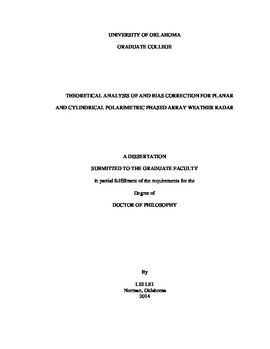| dc.description.abstract | Planar or Cylindrical Phased Arrays are two candidate antennas for the future polarimetric weather radar. These two candidate antennas have distinctly different attributes when used to make quantitative measurements of the polarimetric properties of precipitation. Of critical concern is meeting required polarimetric performance for all directions of the electronically-steered beam. The copolar and cross-polar radiation patterns and polarimetric parameter estimation performances of these two phased array antennas are studied and compared with that obtained using a dual polarized parabolic reflector antenna.
Planar Polarimetric Phased Array Radar (i.e., PPPAR) creates biases in observed polarimetric parameters when the beam is pointed off broadside. The biases of polarimetric parameters with a PPPAR are presented, and it is unacceptably large. Thus, a bias correction matrix needs to be applied for each beam direction. A bias correction matrix is developed for array elements consisting of either dipole, waveguide apertures or patches. Correction matrices are given for both the Alternate Transmission and Simultaneous Reception mode and the Simultaneous Transmission and Simultaneous Reception mode. The PPPAR, however, has significant deficiencies for polarimetric measurements, as well as other limitations, such as increases in beamwidth, decreases of sensitivity, and high geometrically projected cross polar fields when the beam scans off its broadside. The Cylindrical Polarimetric Phased Array Radar (i.e., CPPAR) is proposed to avoid these deficiencies. The CPPAR principle and potential performance are demonstrated through theoretical analysis and simulation. It is shown that the CPPAR has much lower geometrically induced cross-polar fields and less bias of polarimetric parameters than those of PPPAR. Array lattices, element separations, and error effects of CPPAR are examined. | en_US |
